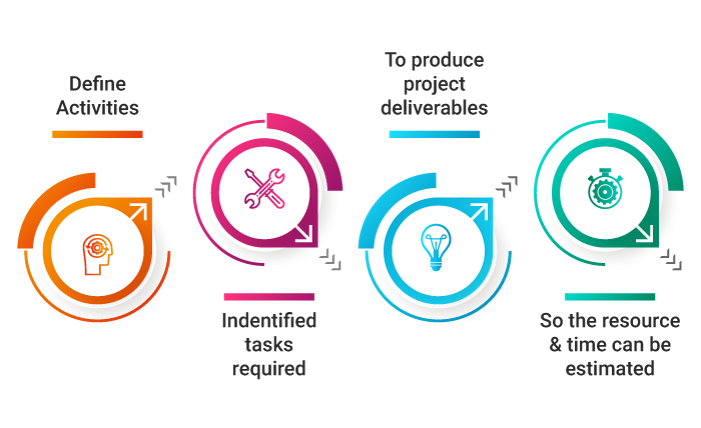
Project Management dates back to the 19th century. Today every organization has realized the benefits of organizing the tasks in the project. Project managers have started identifying the need to communicate and coordinate work across departments and professions. Thus, a defined method of Project Management activities emerged. The end results for every business can be tangible or intangible. But getting to that result, successfully, is what Project Management is all about. Primarily, the Project Management teams mostly focus on the planning and control that involves delivering the result. In this regard, here is a summary of all that Defining Activity list in a Project encompasses.
What does “Defining Activities of a Project” mean?
The Project Management activities characterize the measure of work that changes over a plan for appropriate outcomes. Activities in a project are the method to identify and document the activities that are accessible to produce the project deliverables.
| Do you have the required skills for the role of a Project Manager? Assess today with the online PMP Certification Course. |
Example of Project Management Activities
Let us look at John’s Project Management skills as he manages house-building projects for his client, Josh.
It is a beautiful 3-bedroom duplex house on a land of 3600 square feet. Here is a quick look at the list of activities he has come up with from WBS work packages (blue boxes).
John’s milestone list is:
- Lay Foundation
- Build Structure
- Complete Interiors
- Complete landscaping
He gets the payment at the completion of each of these milestones.
The Benefit of Defining Activities of a Project
The key benefit of this process is that it decomposes work packages into scheduled activities that provide a basis for estimating, scheduling, executing, monitoring, and controlling the project work. This process goes on throughout the project life cycle.
Work Breakdown Structure in Project Management Activities
To define activities in a project, you need to have the work package that is the Work Breakdown Structure, and thus it drives in as the prominent input of the scope baseline. In every project, activities could be estimated, scheduled, monitored, and managed. A project manager should be familiar with two important things:
- Scope baseline
- Availability of a project team
Defining Activities: Enterprise Environmental Factor
Project managers tend to face obstacles while working on projects. The obstructions are caused by a lack of planning or any reasons that can be controlled or not. These situations are enterprise environmental factors.
There are tools for businesses that help in Project Management activities such as planning, WBS budget cost management, scheduling, and change control to deliver the top strategy. It could be utilized to define activities, and such systems are part of enterprise environmental factors.
Enterprise Environmental Factors also influence the defining activities process to incorporate Organizational cultures and structure, Published commercial information from commercial databases, and Project management information system (PMIS) that can impact the Project’s success.
Purpose and Scope Baseline of Defining Activities in Project Management
The purpose of defining activities in a project is to distinguish the particular task that needs finishing with a specific objective to produce the project deliverables. The process should be done in adequate detail to estimate the resources and time that is required to complete it.
Scope baseline is the primary input, consisting of the approved project scope statement, the work breakdown structure, and the WBS dictionary. It acts as the channel between the planning associated with scope management, and the time involved.
What is the Activity list in Project Management?
The activity list is a comprehensive list including all scheduled activities required in the project. The activity list includes the activity identifier and scope of work description for each activity in sufficient detail to ensure the project team members understand what work needs their attention.
Following are five-time management processes of the Activity list as per the PMBOK® guide:
- Sequence Activities
- Estimate Activity Resources
- Estimate Activity Durations
- Develop Schedule
- Control Schedule
Activity attributes extend the description of the activity by identifying the components associated with each one. The components for each activity evolve over time. Activity attributes identify the resource responsible for executing the work, Where the work will be performed, and the activity type. They are used for schedule development and for selecting, ordering, and sorting the planned activities in various ways within reports.
A milestone is a significant point or event in the project. A milestone list identifies all milestones and indicates whether it is mandatory such as those required by contract or optional.
Conclusion
Defining Activities involves the planning of a detailed depiction of the project and its significant deliverables. It requires sufficient data and a proper work breakdown structure to provide the end result. By creating an activity list for a project, you are ensuring proper functioning and the systematic progress of your project. Moreover, you can enroll in the PMP certification training program for enriching project management skills and best practices.
Know more about Project Management best practices through Invensis Learning’s Project Management certification training on PMP Online Training, CAPM Certification Training Course, Prince2 Training Online, Project Management Fundamentals, etc.


















